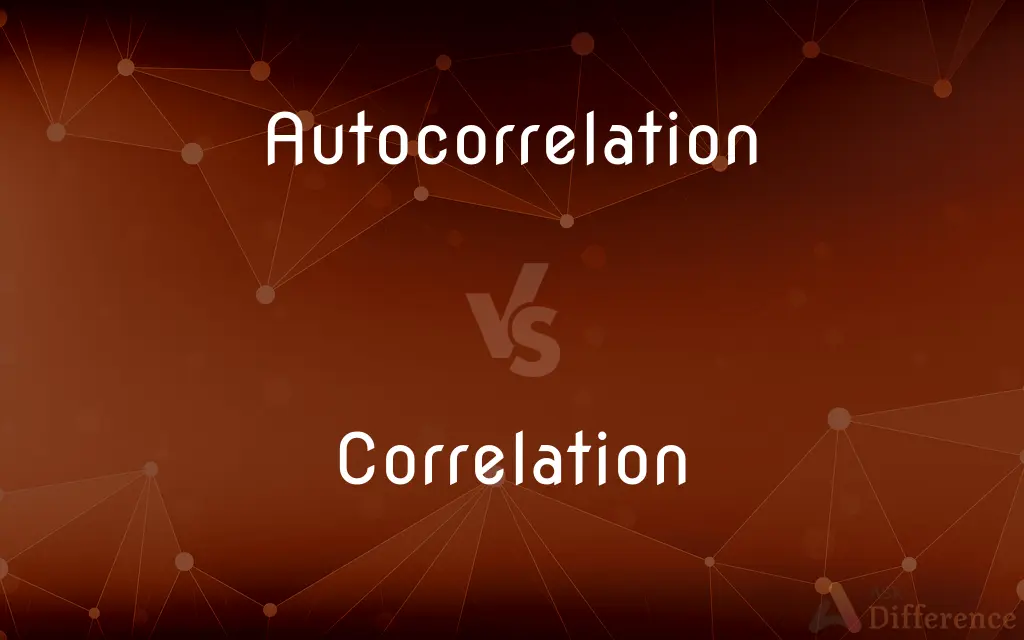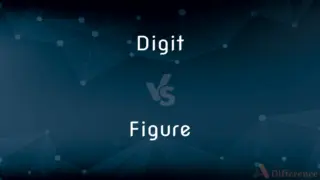Autocorrelation vs. Correlation — What's the Difference?
By Urooj Arif & Maham Liaqat — Updated on March 24, 2024
Autocorrelation is the correlation of a signal with itself at different points in time, while correlation measures the relationship between two distinct variables.

Difference Between Autocorrelation and Correlation
Table of Contents
ADVERTISEMENT
Key Differences
Autocorrelation, also known as serial correlation, is a statistical measure used to determine the degree to which a series of data points, such as stock prices or temperature readings, are related to themselves over successive time intervals. It's specifically focused on identifying patterns within the same dataset across different times, essentially comparing the dataset with a lagged version of itself to identify repetitive patterns or predict future values based on past values. Correlation, in a broader sense, refers to the statistical relationship between two different variables, indicating how one variable moves in relation to another. It measures the strength and direction of this relationship, with values ranging from -1 to 1, where values closer to 1 or -1 indicate a strong relationship, and a value of 0 suggests no relationship.
Autocorrelation can reveal if higher temperatures today can be expected to follow higher temperatures yesterday. Correlation is used across various fields to understand how different variables influence each other, such as the relationship between education level and income.
While autocorrelation applies specifically to a single dataset analyzed over time, correlation encompasses a wider range of applications, comparing two separate datasets to each other. Autocorrelation is a tool for analyzing time series data, helping to understand and predict patterns within that single series. In contrast, correlation is used to explore and quantify the relationship between distinct datasets, not necessarily limited by time.
The importance of autocorrelation in time series analysis lies in its ability to detect non-randomness and to identify repeating patterns, which are crucial for forecasting in fields such as finance and meteorology. Correlation, however, is fundamental in research and statistics for identifying potential causal relationships or associations between variables, aiding in hypothesis testing and model building across diverse disciplines.
Both autocorrelation and correlation are critical in data analysis but serve different purposes. Autocorrelation is key for understanding the internal structure of a single time series dataset, focusing on temporal dependence, while correlation assesses the degree and direction of a linear relationship between two distinct variables, regardless of the time dimension.
ADVERTISEMENT
Comparison Chart
Definition
Correlation of a signal with its delayed self.
Relationship between two distinct variables.
Focus
Identifying patterns within the same dataset over time.
Measuring how one variable relates to another.
Applications
Time series analysis, forecasting.
Broad, including statistics, science, finance.
Value Range
-1 to 1, where 0 indicates no autocorrelation.
-1 to 1, where 0 indicates no correlation.
Key Importance
Detecting repetitive patterns or trends within a single dataset.
Exploring relationships between different variables for analysis or prediction.
Example Use Cases
Analyzing stock market trends, weather patterns.
Studying the relationship between health habits and life expectancy, education and income.
Compare with Definitions
Autocorrelation
Self-comparison over time.
Checking if today's temperature correlates with yesterday's.
Correlation
Measures direction and strength.
Studying the link between study time and exam scores.
Autocorrelation
Identifying patterns in a single dataset.
Finding rhythmic patterns in heart rate data.
Correlation
Not limited by time.
Correlating species diversity with forest area.
Autocorrelation
Used in forecasting.
Using past sales data to predict future sales.
Correlation
Relationship between variables.
Analyzing the correlation between exercise and health.
Autocorrelation
Detects repetitive signals.
Identifying seasonal trends in electricity consumption.
Correlation
Can be positive or negative.
Exploring the relationship between smoking and lifespan.
Autocorrelation
Measures internal consistency.
Determining the reliability of a repeated psychological test.
Correlation
Broad application.
Investigating the association between air quality and respiratory issues.
Autocorrelation
Autocorrelation, sometimes known as serial correlation in the discrete time case, is the correlation of a signal with a delayed copy of itself as a function of delay. Informally, it is the similarity between observations as a function of the time lag between them.
Correlation
In statistics, correlation or dependence is any statistical relationship, whether causal or not, between two random variables or bivariate data. In the broadest sense correlation is any statistical association, though it commonly refers to the degree to which a pair of variables are linearly related.
Autocorrelation
The cross-correlation of a signal with itself: the correlation between values of a signal in successive time periods.
Correlation
A relationship or connection between two things based on co-occurrence or pattern of change
A correlation between drug abuse and crime.
Correlation
(Statistics) The tendency for two values or variables to change together, in either the same or opposite way
As cigarette smoking increases, so does the incidence of lung cancer, indicating a positive correlation.
Correlation
An act of correlating or the condition of being correlated.
Correlation
A reciprocal, parallel or complementary relationship between two or more comparable objects.
Correlation
(statistics) One of the several measures of the linear statistical relationship between two random variables, indicating both the strength and direction of the relationship.
Correlation
(algebra) An isomorphism from a projective space to the dual of a projective space, often to the dual of itself.
Correlation
Reciprocal relation; corresponding similarity or parallelism of relation or law; capacity of being converted into, or of giving place to, one another, under certain conditions; as, the correlation of forces, or of zymotic diseases.
Correlation
A reciprocal relation between two or more things
Correlation
A statistic representing how closely two variables co-vary; it can vary from -1 (perfect negative correlation) through 0 (no correlation) to +1 (perfect positive correlation);
What is the correlation between those two variables?
Correlation
A statistical relation between two or more variables such that systematic changes in the value of one variable are accompanied by systematic changes in the other
Common Curiosities
Can correlation imply causation?
While correlation can indicate a relationship between two variables, it does not necessarily imply that one causes the other.
What is the key difference between autocorrelation and correlation?
Autocorrelation measures the relationship of a dataset with itself over time, whereas correlation measures the relationship between two different variables.
Can autocorrelation be used for forecasting?
Yes, it's particularly useful in predicting future values of a time series based on its past values.
Why is correlation important in research?
It helps identify potential relationships between variables, which can inform hypotheses and guide further study.
Does a high autocorrelation mean a dataset is predictable?
High autocorrelation indicates that the dataset's past values can be useful in predicting its future values, thus potentially making it more predictable.
Is it possible to have negative autocorrelation?
Yes, negative autocorrelation occurs when higher-than-average values are followed by lower-than-average values in a patterned sequence.
How does the value range of autocorrelation and correlation compare?
Both range from -1 to 1, where values near the extremes indicate strong relationships, and values near 0 indicate weak or no relationship.
What role does autocorrelation play in model diagnostics?
It helps in assessing the fitness of a model by checking for the independence of residuals in time series analysis.
How can correlation be misleading?
Correlation can be misleading if spurious or if it obscures the true nature of the relationship between variables, especially when confounding variables are involved.
What tools are commonly used to measure autocorrelation and correlation?
Statistical software and programming languages like R, Python, and MATLAB offer functions and libraries specifically designed to calculate and analyze both autocorrelation and correlation.
Share Your Discovery

Previous Comparison
Digit vs. Figure
Next Comparison
Pleonasm vs. TautologyAuthor Spotlight
Written by
Urooj ArifUrooj is a skilled content writer at Ask Difference, known for her exceptional ability to simplify complex topics into engaging and informative content. With a passion for research and a flair for clear, concise writing, she consistently delivers articles that resonate with our diverse audience.
Co-written by
Maham Liaqat













































